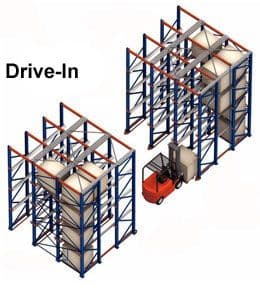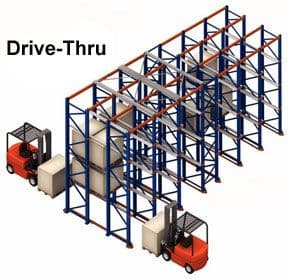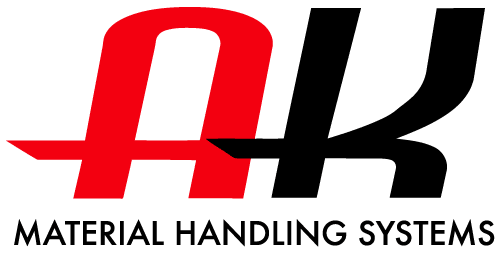Drive-in and drive-through pallet racking are two high-density storage systems used in warehouses and distribution centers. While they have similarities, they differ in their design and functionality. Here’s an overview of the key differences between drive-in vs. drive-through pallet racking.


Features of Drive-In Racking
Drive-in racking is simple because it possesses only entry loading points, which makes for a more accessible and less complicated warehouse layout structure. Features of Drive-in styles include:
- Structure: Drive-in pallet racking is typically constructed with upright frames and horizontal beams that create multiple storage lanes. These lanes are designed to accommodate forklifts, allowing them to drive into the structure for pallet placement or retrieval.
- Entry and Exit: With drive-in racking, pallets are loaded and unloaded from the same side, usually the front side. Forklifts enter the storage lanes, often in a single direction, to place or retrieve pallets. This design optimizes space utilization by eliminating the need for aisles between the racking bays.
- LIFO: Drive-in racking systems typically follow the Last-In, First-Out (LIFO) principle. Since the most recently loaded pallets are stored behind the front ones, the retrieval of pallets occurs in reverse order. This function makes drive-in racking suitable for products that do not require strict inventory rotation and have a longer shelf life.
- High-Density Storage: Drive-in racking is known for its high-density storage capabilities. By minimizing aisle space, this system allows for the efficient utilization of available warehouse space. It is beneficial for storing large quantities of the same product, such as perishable goods or products with minimal variation.
- Limited Selectivity: The primary drawback of drive-in racking is its limited selectivity. Since pallets are stored in multiple depth positions within the storage lanes, accessing pallets located deeper in the structure requires removing the front pallets. These limitations can result in slower retrieval times and reduced accessibility compared to systems with greater selectivity, such as selective racking.
Products typically stored using Drive-in racking include Fast-Moving Consumer Goods (FMCG). Products frequently replenished and in high demand are well-suited for drive-in racking. Canned goods, toiletries, cleaning supplies, and packaged goods can be stored in large quantities. Drive-in racking allows for efficient use of space while ensuring quick access to the latest arrivals at the front of the storage lanes.
Features of Drive-Through Racking
Drive-through pallet racking is an excellent option for a more customizable and controlled rotation of goods. This feature makes it more universal as it can fit better with a broader range of storage needs. Some features of drive-through racking are:
- Structure: Drive-through pallet racking shares a similar structural design with drive-in racking, featuring upright frames and horizontal beams that create storage lanes. However, it includes two entry points, typically one on each end of the racking structure.
- Entry and Exit: Forklifts can enter the storage lanes from either end of the racking structure in a drive-through system. This dual-entry configuration allows pallets to be loaded on one end and retrieved from the opposite end. It provides more pallet placement and retrieval flexibility, enhancing operational efficiency.
- FIFO Principle: Drive-through racking systems usually follow the First-In, First-Out (FIFO) principle. By allowing access to both ends of the storage lanes, it enables systematic inventory rotation. Pallets can be loaded on one end, and as new stock arrives, older stock can be retrieved from the other end, ensuring proper inventory rotation. Drive-through racking can also follow a LIFO principle if desired.
- Moderate Selectivity: Drive-through racking offers better selectivity compared to drive-in racking. Forklifts can access the front and back pallets within the storage lanes, allowing for easier inventory management. This system is beneficial when there is a need to access various products or when inventory turnover is more frequent.
- Balanced Load Distribution: Since drive-through racking permits entry and exit from both ends, it promotes a more balanced load distribution across the storage lanes. Evenly distributing the weight helps maintain the racking system’s structural integrity and prevents specific lanes’ overloading. This feature is particularly advantageous when storing heavy or bulky items that require a balanced weight distribution.
Looking For Drive-In/Drive-Through Racking?
Here at PRN, we offer selective racking components online from two highly-rated pallet rack manufacturers: Steel King and Ridg-U-Rak. These manufacturers make selective racking as well as drive-in, drive-through, and several other pallet rack systems. Call 888-578-1578 to learn more, or get in touch with AK Material Handling Systems, our warehouse design division, to purchase and begin implementing a drive-in/drive-through system in your warehouse.


